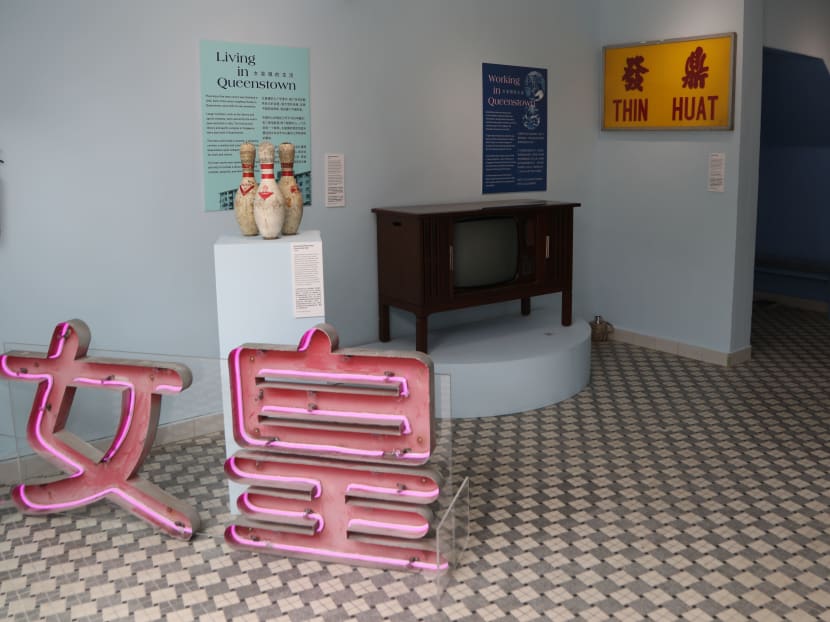Residents love Queenstown, so a community museum was born to hold their memories
SINGAPORE — Queenstown has been home to many firsts. Slated as Singapore’s first satellite town in 1953, it was where the first flatted factory and the first few blocks of Housing and Development Board (HDB) flats were built. The town was even featured on the first series of dollar bills in circulation.
Now, Queenstown may have what could be Singapore’s first independent community museum — funded, curated and managed mostly through the efforts of its residents.

Queenstown may have what could be Singapore’s first independent community museum — funded, curated and managed mostly through the efforts of its residents.
SINGAPORE — Queenstown has been home to many firsts.
Slated as Singapore’s first satellite town in 1953, it was where the first flatted factory and the first few blocks of Housing and Development Board (HDB) flats were built.
The town was even featured on the first series of dollar bills in circulation.
Now, Queenstown may have what could be Singapore’s first independent community museum — funded, curated and managed mostly through the efforts of its residents.
Nestled in a humble shophouse in the mature Tanglin Halt housing estate, Museum @ My Queenstown serves as a repository of old photographs and artefacts that tell various stories about Queenstown.
Mr Kwek Li Yong, 29, is the president and co-founder of My Community, a civic charity group that is behind this museum project. A group of about 250 volunteers organise guided tours, exhibitions, festivals and other art and heritage programmes in Queenstown, Bukit Merah and Tiong Bahru.
Mr Kwek, who also works as a heritage research consultant, said: “The museum narrates the endearing story of the common man, immortalises our collective memory as a community and celebrates the little things which make Queenstown special.”
Among the items on display is a signboard of a family-run provisions shop, Thin Huat, which had been serving the community for more than five decades before closing due to pressures from competing supermarket chains and the proprietors’ declining health.
It was an institution in its own right, and in the final weeks before its closure in April last year, its regular elderly customers went to buy up large quantities of rice, which they were used to eating almost their entire lives. Some were simply hovering around the stall, reluctant to leave, Mr Kwek recalled.
All these memories will be captured as part of the museum’s first exhibition titled Our Stories: Do You Remember Them?.
It is the result of nine years of collecting physical and digital artefacts that tell of Queenstown’s history and heritage, and it will try to evoke conversations about the estate’s future.
Programme spaces on the second level of the shophouse will host a series of talks, seminars and workshops on “anything and everything” related to the project.
There is also an archival room holding various artefacts such as signages from the Palace KTV and housing blocks 74 to 80, as well as more than 2,000 rare photographs of Queenstown.
The museum’s launch event takes place on Saturday (Feb 23) from 6pm to 7pm, with Senior Parliamentary Secretary Baey Yam Keng as guest-of-honour.
The Quests, a popular Singapore band in the 1960s that was named after the then Queenstown Secondary Technical School, were roped in to perform at the launch.
A PLACE TO ‘LOCK UP’ MEMORIES
One resident who calls Queenstown home despite the many changes over the years is insurance sales agent Chen Kim Yen, who has been living in the area since she was four.
The 47-year-old, who volunteers as a guide and treasurer at My Community, said: “Heritage is not about keeping everything, but you need to have a place to lock up memories.”
Mr Kwek said: “We’ve always wanted a museum here because we know the residents love Queenstown. It was a request from the residents that they wanted a museum here.”
However, it took My Community many years to plan, collect artefacts and stories, and to get approvals from more than five different government agencies before the museum took shape.
Through the experience, Mr Kwek believes that he has found a sustainable model for non-profit organisations in Singapore which does not have to rely on government funding.
The civic charity group raised more than S$250,000 mostly from residents, businesses and religious institutions located in Queenstown, including Tiong Ghee Temple, Sri Muneeswaran Temple and Faith Methodist Church.
The lack of reliance on government funding gives the museum freedom to display artefacts and exhibits of its choosing, even if they may not conform to the mainstream Singapore story, Mr Kwek said.
Dr Chia Shi-Lu, Member-of-Parliament for Tanjong Pagar Group Representation Constituency, said in a press statement that Museum @ My Queenstown “is a testament to the growing maturity of the cultural and heritage sector in Singapore where residents take the front seat”.
“By involving the community in every phase of planning, the museum imbues a greater sense of belonging, rootedness and attachment to the community,” he added.
Madam Chang Mew Ling, 76, who has lived in Tanglin Halt for 50 years, said in Mandarin: “It brings me joy, to recollect some old memories.
“Even though some from the older generation are no longer around, at least we have things to preserve for the next generation. Or else they won't know anything.”
In 2014, Mdm Chang’s flat along Commonwealth Drive was identified for the Selective En Bloc Redevelopment Scheme. She will be moving to the Dawson area in Queenstown in 2020.
“I can’t bear to leave,” she said. “I’ve lived here for so many years.”
Residents such as Mdm Chang is the reason why My Community chose Tanglin Halt as its location for the museum for now. Come 2020, it will move over to Dawson, where it will occupy a larger community art and heritage centre.
Mr Kwek said: “At least when residents move, they see something familiar.”











